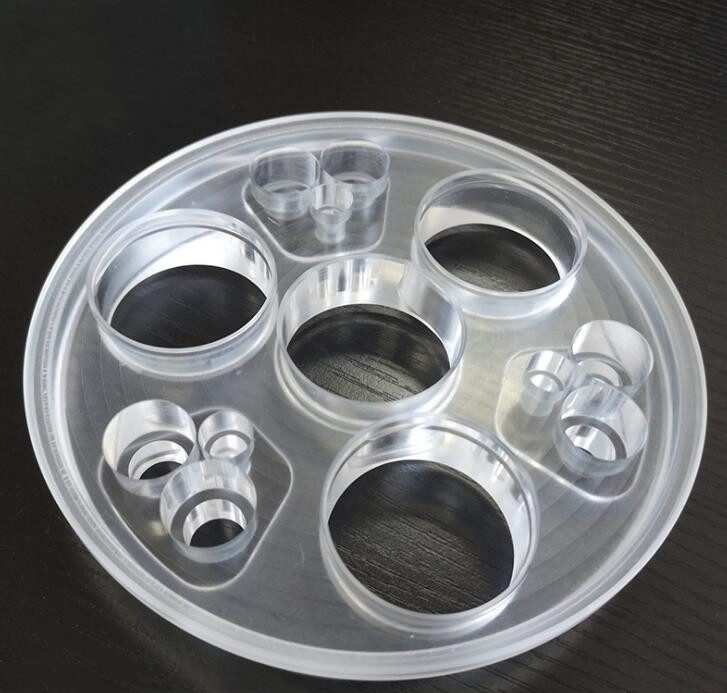-
- What Is Acrylic?
- What are the Advantages and Disadvantages of Acrylic?
- What Is PC?
- What are the advantages and disadvantages of PCs?
- What are the Differences between CNC Machining PC and Acrylic?
- Tips to Choose the Right One for Your Project: CNC Machining Polycarbonate (PC) vs. Acrylic (PMMA)
- Conclusion
- FAQ
CNC Machining Polycarbonate (PC) vs. Acrylic (PMMA): Detailed Comparison
When approaching the topic of materials in CNC machining, it’s crucial to consider not just the technical aspects but also how your choice impacts the overall project outcome. Imagine you are about to start a critical component for a new product, and the decision boils down to two popular plastics: polycarbonate (PC) and acrylic (PMMA). Both materials boast unique properties that could make or break your application’s success. Your choice could enhance the product’s durability, affect its aesthetic appeal, or even dictate its functionality.
In CNC machining, selecting a suitable plastic material is pivotal. Polycarbonate is renowned for its incredible impact resistance and clarity, ideal for demanding environments. Acrylic, on the other hand, is celebrated for its excellent clarity and ease of machining, making it perfect for aesthetically focused applications.
To keep you hooked, I’ll delve into the nuances that differentiate these materials on a technical level and in real-world applications. It’s these details that could dramatically influence your decision-making process.
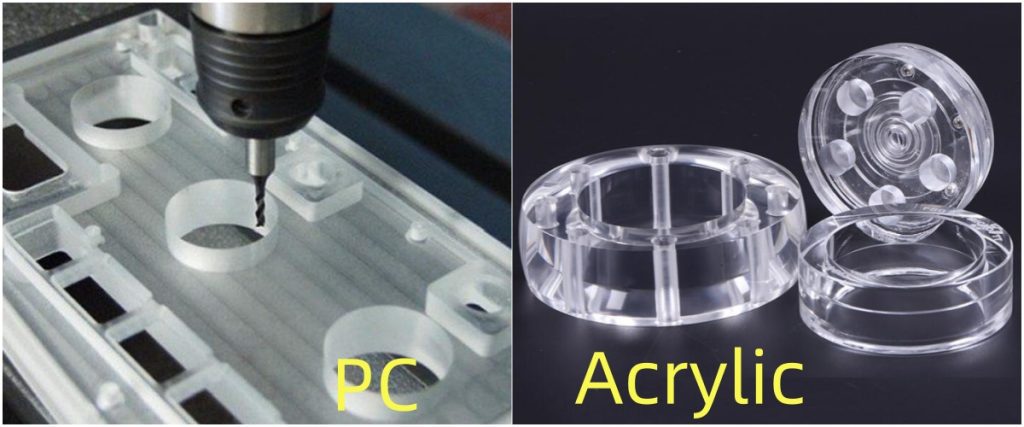
What Is Acrylic?
Acrylic, scientifically known as Polymethyl Methacrylate (PMMA), is a transparent thermoplastic often used as a lightweight, shatter-resistant alternative to glass. Acclaimed for its clarity and resistance to UV light, acrylic is commonly seen in applications ranging from window panes and light fixtures to artistic installations and protective barriers. Its ability to be easily machined, bonded, and polished makes it a favored choice in various industries for functional and decorative purposes.
Acrylic’s versatility is also evident in its various forms; it can be extruded or cast, with each form offering slight differences in mechanical properties. Cast acrylic is generally more rigid and scratch-resistant, whereas extruded acrylic is more malleable. This flexibility in its physical form and properties allows designers and engineers to use acrylic innovatively to achieve specific aesthetic and functional goals.
What are the Advantages and Disadvantages of Acrylic?
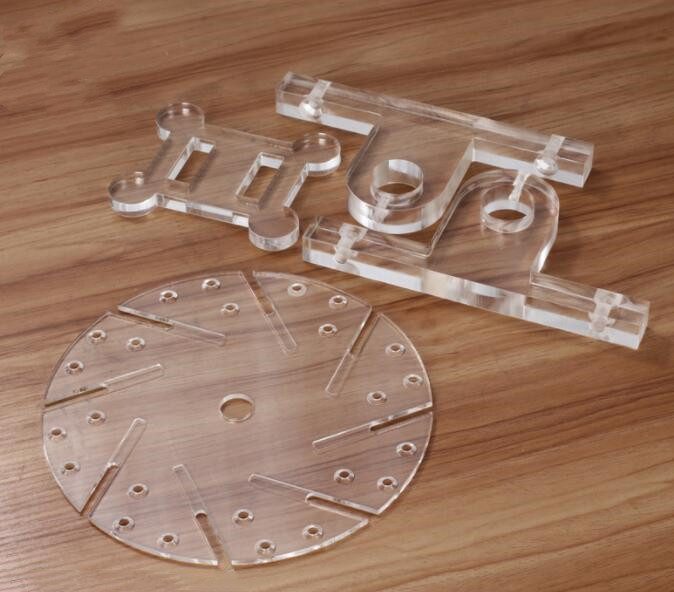
Advantages of Acrylic:
- Optical Clarity: Acrylic stands out for its exceptional clarity and transparency, maintaining up to 92% light transmittance.
- UV Resistance: Unlike many plastics, acrylic is inherently resistant to UV light, which prevents it from yellowing over time when exposed to sunlight.
- Impact Resistance: While not as robust as polycarbonate, acrylic is still 17 times more impact-resistant than ordinary glass, which makes it a safer alternative for use in windows, signs, and light fixtures.
- Machinability: Acrylic is more accessible to cut, drill, and shape than many other transparent materials, which allows for intricate designs and smooth finishes in manufacturing. It’s compatible with CNC machines, laser cutters, and traditional woodworking tools.
- Chemical Stability: Acrylic is resistant to most common household chemicals and cleaning solutions, which ensures longevity and ease of maintenance in consumer products and installations.
Disadvantages of Acrylic:
- Brittleness: Despite its impact resistance, acrylic can be brittle, particularly when exposed to sharp impacts or stresses, leading to cracking or shattering.
Scratch - Sensitivity: Acrylic surfaces are prone to scratches and require special care or protective coatings to maintain their clear and polished look.
- Thermal Sensitivity: Acrylic can expand and contract more than other materials when exposed to extreme temperatures, which might affect its performance in applications subject to varying climates.
- Cost: Depending on the application and the required quality, acrylic can be more expensive than other plastics, particularly for thicker sheets in high-stress applications.
- Flammability: Acrylic burns more readily than many other building materials, emitting toxic fumes such as hydrogen cyanide when it does burn. This can be a significant hazard in specific applications, requiring careful consideration of safety and compliance with fire regulations.
What Is PC?
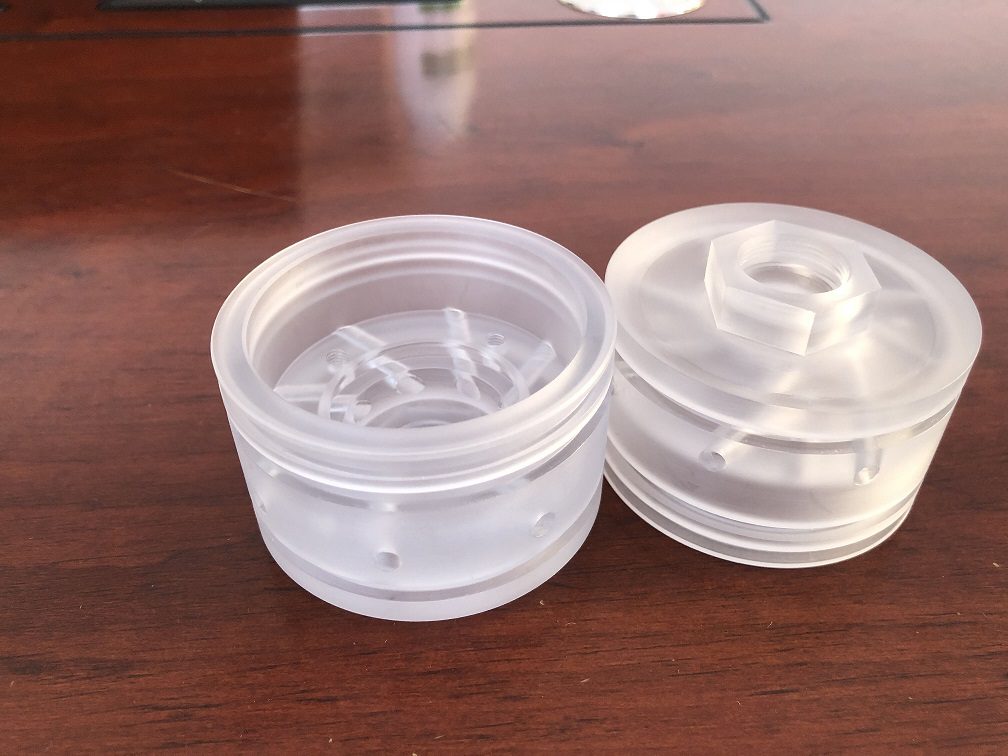
Polycarbonate (PC) is a rigid thermoplastic material widely known for its durability and strength. This high-performance plastic is made from bisphenol A and phosgene, and it features a unique blend of properties that make it ideal for a wide range of applications. Polycarbonate is particularly noted for its impact resistance, being able to withstand massive forces without cracking or breaking, which is why it’s used in products from bulletproof windows to compact discs.
The versatility of polycarbonate extends beyond its strength. It is naturally transparent, transmitting nearly as much light as glass while being much more impact-resistant. This property makes PC an excellent choice for eyewear lenses, automotive headlamps, and various protective covers in industrial settings.
Furthermore, polycarbonate can be easily molded and thermoformed, which means it can be shaped at relatively low temperatures compared to other thermoplastics, expanding its use in complex manufacturing processes.
What are the advantages and disadvantages of PCs?
Advantages of Polycarbonate (PC):
- Exceptional Impact Resistance: Polycarbonate is best known for its outstanding impact resistance. It is virtually unbreakable and is used in highly durable applications, such as bulletproof glass, sports equipment, and automotive components.
- High Transparency: PC offers excellent clarity and light transmission, comparable to glass. This makes it suitable for applications like safety goggles, face shields, and any setting where clear vision is crucial without the risk of shattering.
- Temperature Resistance: Polycarbonate performs well under varying temperatures, maintaining its integrity from -40 to 120 degrees Celsius. This thermal stability is essential for applications subjected to harsh environmental conditions.
- Versatility: PC can be laminated, coated, or treated to enhance its properties, such as scratch resistance, UV stability, or color. It can also be easily thermoformed or machined, which makes it adaptable to complex designs and shapes.
- Lightweight: Despite its strength and durability, polycarbonate is lightweight compared to glass, which reduces the overall weight of products and contributes to energy efficiency, particularly in automotive and aerospace applications.
Disadvantages of Polycarbonate (PC):
- Cost: Polycarbonate is generally more expensive than other plastics like acrylic, which can be a limiting factor in budget-sensitive projects.
- Scratch Susceptibility: While PC is impact resistant, it is more prone to scratching than other materials like acrylic or glass. Surface treatments or hard coatings are often required to mitigate this issue.
- Chemical Sensitivity: Polycarbonate can be sensitive to certain chemicals, including solvents and harsh cleaners, leading to cracking or degradation. This requires careful consideration of environmental factors in its applications.
- Thermal Expansion: PC experiences more thermal expansion than other materials, which can be critical in applications where precision and fit are essential, especially under fluctuating temperatures.
- UV Degradation: Although it has good transparency, untreated polycarbonate can degrade when exposed to UV radiation, leading to yellowing or brittleness over time. UV-resistant coatings are essential for outdoor applications to ensure longevity.
What are the Differences between CNC Machining PC and Acrylic?
Machinability
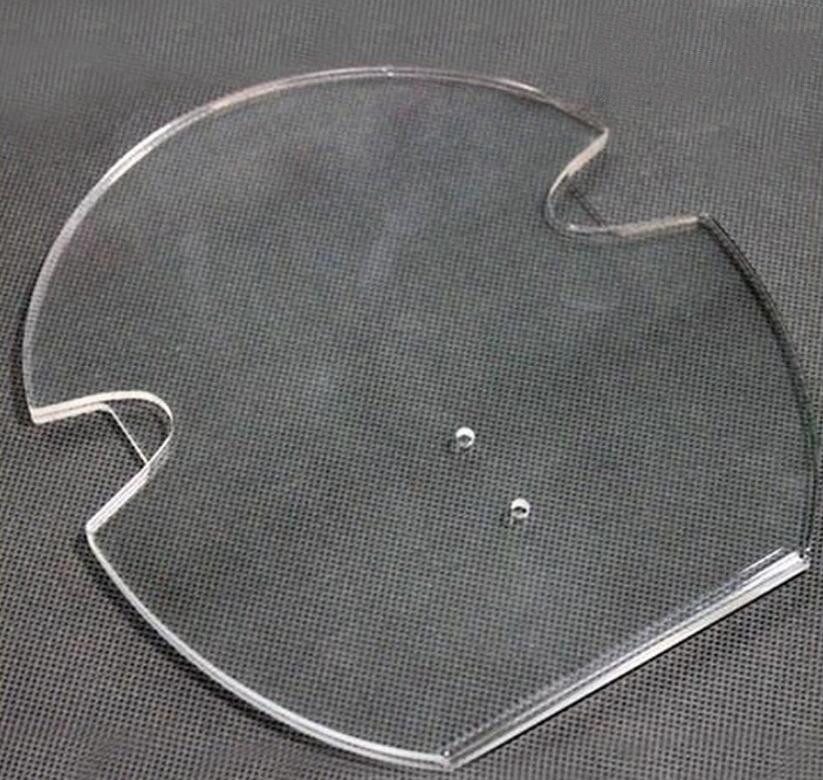
Polycarbonate (PC) is more rigid and flexible than acrylic, allowing it to endure the machining process without cracking. However, this toughness can also make a PC more challenging to machine precisely as it may deform or bend, especially in thinner configurations. Special attention must be given to tool selection and cutting speed to prevent melting or warping due to heat generated during machining.
Acrylic (PMMA), while more brittle than polycarbonate, is easier to machine to a high-quality finish. It tends to chip rather than melt, allowing for a smoother cut when using sharp, adequately configured tools. Acrylic’s brittleness, however, means that it can crack or shatter if not handled carefully during the machining process, especially near edges or when drilling holes.
Finish Quality
PC generally provides a good finish but can require additional processes, such as flame polishing or sanding, to achieve the high clarity and smoothness that acrylic naturally possesses. Due to its flexibility, polycarbonate might show marks or small deformations after machining if not appropriately supported.
Acrylic offers excellent clarity and a glossy finish directly after machining, often not requiring additional finishing processes. This makes it particularly suitable for aesthetic components where a clear, glass-like appearance is desired.
Heat Tolerance
During machining, both materials generate heat, but they react differently. Polycarbonate can withstand higher temperatures before deforming, which is advantageous in more intensive machining operations. Acrylic may require careful management of machining speeds and feeds to avoid generating excessive heat that could lead to melting or burning.
Tool Wear
Machining PCs tend to cause more wear on tools due to their toughness and the need for higher force during cutting. This can increase the cost and time of machining operations as tools may need more frequent replacement or sharpening.
Acrylic, being softer, generally causes less wear on tools, which can be beneficial for longer production runs or when using delicate machining techniques.
Cost Implications
Given the differences in tool wear, heat management, and finishing requirements, PC might be more costly to machines than acrylic, especially for complex or high-precision parts. However, the choice often depends on the specific requirements of the final product, including its mechanical properties and environmental exposure.
Tips to Choose the Right One for Your Project: CNC Machining Polycarbonate (PC) vs. Acrylic (PMMA)

1. Consider the Application Environment
- Impact and Stress: If your component needs to withstand the high effects or is subject to mechanical stress, polycarbonate’s superior toughness makes it the better choice.
- Exposure to Sunlight: Acrylic may degrade unless treated explicitly for outdoor applications or environments where UV exposure is significant. Polycarbonate usually offers better resistance to UV radiation, though it can still benefit from UV-stabilizing treatments.
2. Evaluate Aesthetic Requirements
- Clarity and Finish: If aesthetic appeal and clarity are paramount, acrylic’s natural gloss and transparency make it ideal, especially for display cases or transparent covers. Polycarbonate is sufficiently clear for applications where slight color distortion is permissible and offers additional durability.
- Finishing Processes: Consider the need for post-machining finishing. Acrylic often requires fewer finishing steps to achieve a high-quality surface than polycarbonate, which may need additional sanding or polishing.
3. Assess Machinability and Production Techniques
- Machining Complexity: Acrylic is generally easier to machine with less wear on tools, making it suitable for intricate designs and finer details. However, care must be taken to avoid cracking. Polycarbonate is more forgiving of rough handling but might require specific tooling or adjustment of cutting parameters to manage its flexibility and heat sensitivity.
- Production Volume: For high-volume runs, the tool wear rate and ease of machining can affect overall costs. Acrylic’s lower wear on tools can be a cost advantage in large-scale production settings.
4. Analyze Long-term Durability and Maintenance
- Maintenance Requirements: Acrylic can scratch easily, so if the product requires minimal maintenance and needs to remain visually appealing without regular upkeep, polycarbonate may be a better choice.
- Temperature and Chemical Exposure: If your project involves exposure to high temperatures or harsh chemicals, polycarbonate’s superior resistance will likely be necessary to ensure longevity and performance.
5. Cost vs. Performance Trade-offs
- Budget Constraints: Always balance the cost with the performance requirements. While polycarbonate is generally more expensive, its durability and resistance might reduce replacement costs over time, offering better long-term value for specific applications.
Conclusion
If you’re weighing the options between CNC machining polycarbonate and acrylic for your next project, we’re here to help guide you to the best solution. Contact us for expert advice tailored to your specific needs, ensuring your project’s success with the ideal material choice.
FAQ
Q: What are the typical applications for CNC machined acrylic and polycarbonate?
A: Due to its clarity and aesthetic finish, CNC machined acrylic is often used for decorative items, retail displays, and light fixtures. Polycarbonate is chosen for parts requiring high impact resistance, such as protective gear, automotive components, and bulletproof glass.
Q: Is there a difference in the lead time between machining polycarbonate and acrylic?
A: Typically, acrylic might have shorter lead times due to its easier machinability than polycarbonate.


